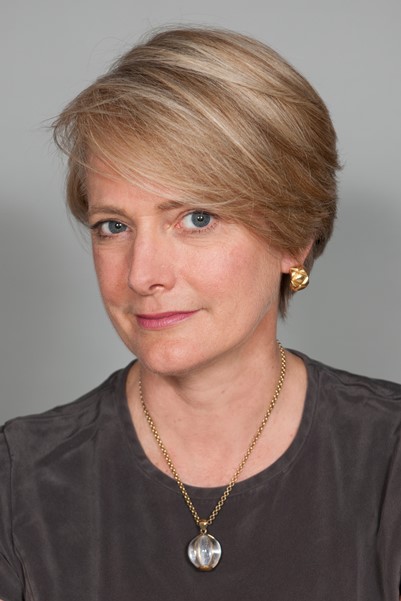Findmypast Library Edition: Request it At Your Public Library!
 findmypast now has a Library Edition available within the United States. Patrons of subscribing libraries can now have access to their billions of records from England, Ireland, Wales, Scotland, Australia, New Zealand, Canada and the United States.
findmypast now has a Library Edition available within the United States. Patrons of subscribing libraries can now have access to their billions of records from England, Ireland, Wales, Scotland, Australia, New Zealand, Canada and the United States.
Highlights of what you’ll find on findmypast Library Edition include:
- Largest online collection of U.K. parish records;
- Exclusive access to the new PERiodical Source Index (now with images);
- Most comprehensive Irish family history records in the world.
Findmypast’s version of PERSI, the Periodical Source Index, includes more than 2.5 million indexed entries from thousands of genealogical and local history publications–AND a growing number of digitized articles! Click here to read more about PERSI, which we love.
Here’s How You Can Use FindMyPast for Free
We asked Josh Taylor at FMP how subscribers and non-subscribers can use the Library Edition:
1) “FMP subscribers can login to their own accounts while at the library.”
2) “Also, library users who are not paid subscribers can create a free account that allows them to create a tree, store, and attach records they view while at the library. The free account works like a standard Findmypast account so can be used at home to access their tree (and even get automatic hints).”
We’ve blogged about the Hints feature here at Genealogy Gems.
 Ready to do some library research? We’ve got more tips for you, like:
Ready to do some library research? We’ve got more tips for you, like:
- 5 Genealogy Resources to Look For at YOUR Public Library;
- A three-part series on visiting free local Family History Centers in our FREE Family History Made Easy podcast, episodes 17-19;
- This post on the MyHeritage Library Edition, now available at Family History Centers; and
- Use your iPad for Genealogy Research at the Family History Library.
Finally, here’s an important tip: let your voice be heard at your public library! They need to know how many people care about genealogy and family history. They need to know what databases you’re most interested in accessing. In an era of struggle for many public libraries, they have to prioritize their energies, so tell them what you want to learn!
SSDI Search – How to Find Hard to Find Ancestors
Social Security Death Index (SSDI) search is not necessarily as straight forward as you might think. We’re going to explore what SSDI records are, their range of availability, and how they compare across the Genealogy Giants records websites.

If you’ve been dabbling in genealogy research for a while, then you are very likely familiar with the Social Security Death Index, more commonly referred to as the SSDI. But even experienced researchers have questions, like the one that Marti sent me recently:
From Marti in Texas:
Hi Lisa!!
Thank you so much for all your helpful resources on your website!! I just listened to the SSDI Working Backwards podcast episode (Family History: Genealogy Made Easy episode 3) and my grandparents passed away in 2012 and 2014. Do you know when the last time the index has been updated, I cannot locate them.
Thank you so much!!
This two-fold question is a good one. While many genealogical record sets have privacy laws that dramatically restrict more recent records from being available, the SSDI is not one of them. But even if the records are available, there may still be times when we have trouble locating our relatives.
Whenever you run into a road block finding ancestors in a record collection, do what good detectives do, and go back to the beginning. In this case, let’s learn more about the collection itself.
Social Security Death Index Background
The Social Security Act was signed into law in 1935 by President Franklin Roosevelt. By 1937, more than 30 million Americans had registered. Today, the Death Master File from the Social Security Administration contains around 90 million records of deaths and they are publicly available online.
Some data goes as far back as 1937, but most of the information included in the SSDI dates from 1962. This is because the Social Security Administration began to use a computer database for processing requests for benefits in 1962. Some of the earlier records back to 1937 have not been added.
It’s important to know that the SSDI does not have a death record for everyone. It’s also very possible that you may occasionally find an error here and there if something was reported incorrectly. But don’t let that stop you from tapping into this major resource! It’s a wonderful alternative source for finding people who were counted in the 1890 census (which was unfortunately mostly destroyed) because they may still appear in the SSDI. Also, those who were born before vital records registration in their home state began, may also show up. Remember, working folks just had to live past 1937 to have been possibly included. That means some people could have been born sometime in the late 1800s.
Now that we have a handle on the history of the SSDI, let’s look at who has it and how recent their records are.
Where to Find the SSDI
The Social Security Death Index (SSDI) is available on all of the ‘big 4’ genealogy records websites, which we here at Genealogy Gems refer to as the “Genealogy Giants.” The links below will take you directly to the SSDI search page for each.
- FamilySearch
(Current as of February 28, 2014) - Ancestry
(1935-2014) - MyHeritage
(It is not stated how current the database is, but a search for 2014 did retrieve results) - Findmypast
(No dates or citation provided, but a search for people who died in 2014 did retrieve results)
In Marti’s case, she will want to search every single one of these websites for her ancestors. The good news is that they all appear to be up-to-date, but that doesn’t mean they are all exactly the same. The same collection of genealogy records can appear differently from site to site for a number of reasons such as accidental omissions, variations in the power of their search engine, differences between indexers and scanners, and Optical Character Recognition (OCR) inaccuracies. These may or may not affect the SSDI, but the point is that you can’t go wrong searching each one of the Genealogy Giants just in case. And since SSDI search can be conducted for free at all of the Genealogy Giants, it doesn’t cost you anything to do so.
A quick way to find all of the websites that include the SSDI is to Google SSDI genealogy. Here’s a link to the results.
SSDI Search Head-to-Head Comparison
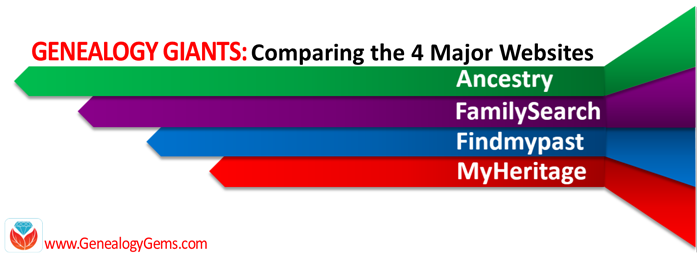 Another excellent reason to search the SSDI on multiple websites is that each website displays the information a little differently. And as you can see from the chart below, when it comes to the Genealogy Giants, there are definitely differences.
Another excellent reason to search the SSDI on multiple websites is that each website displays the information a little differently. And as you can see from the chart below, when it comes to the Genealogy Giants, there are definitely differences.
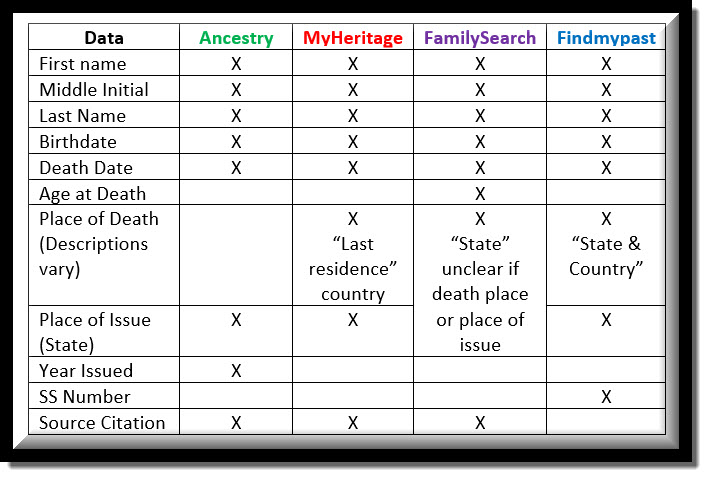

The differences between the 4 major websites can be sometimes subtle or quite dramatic. Understanding their strengths and weaknesses, as well as free versus subscription offerings, is key to successful research that is both efficient and cost-effective.
The quick reference guide Genealogy Giants: Comparing the 4 Major Websites is a must-have for anyone serious about getting the most out of free and paid subscriptions.
SSDI Search and Beyond
There is another database at Ancestry that is worth keeping your eye on. It’s called the U.S. Social Security Applications and Claims Index and it shouldn’t be missed! Currently, this covers 1936-2007, but who knows, they may update it in the future. It includes even more information. It was first released in 2015. Read more about it here at Genealogy Gems.
Gems: Share Your SSDI Search Experience!

I invite you to take a moment to share your SSDI search experience in the comments below. Have you had any surprises? Did you find a difference between the records found at different websites? We want to hear your story because we all benefit from each other’s experiences.
Disclosure: This article contains affiliate links and Genealogy Gems will be compensated if you make a purchase after clicking on these links (at no additional cost to you). Thank you for supporting Genealogy Gems!
Genealogy Gems Podcast Episode 213
In this episode, I’ll share a moving family history video, inspired by a listener’s Where I’m From poem. We’ll also discuss RootsTech news, talk to author Sylvia Brown, and Michael Strauss will explain the difference between different kinds of military service: regulars, volunteers and militia in Military Minutes. Listen here or through the Genealogy Gems app.
The Genealogy Gems Podcast
Episode #213
with Lisa Louise Cooke
NEWS: HENRY LOUIS GATES, JR TO KEYNOTE ROOTSTECH
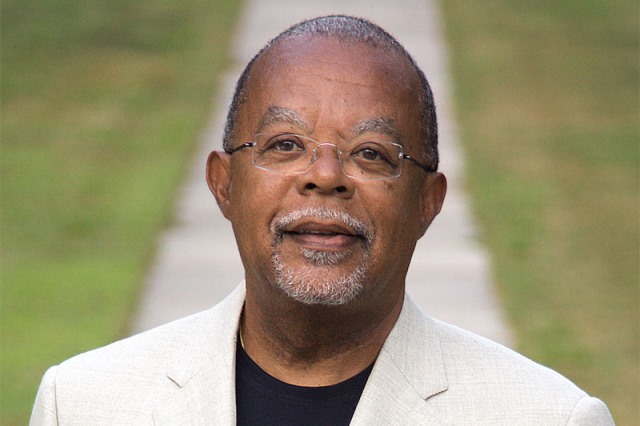
Click here to read about all RootsTech keynote speakers
Click here to hear Lisa Louise Cooke’s conversation with Henry Louis Gates, Jr. in the Genealogy Gems Podcast episode 133
GEMS NEWS: UPDATED PREMIUM VIDEO
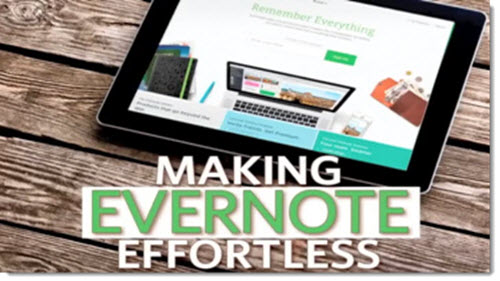
Genealogy Gems Premium subscribers can now enjoy an updated version of Lisa’s Premium video, “Making Evernote Effortless.” You’ll learn how to use Evernote’s:
- Quick Keys: Help you get things done faster
- Search Operators: Digging deeper and faster into your notes
- Shortcuts: Learn how to set them up to accomplish repetitive tasks faster
- Reminders: Help you track and meet deadlines
- Note Sharing: Collaboration just got easier
- Source Citation: Merging notes to include sources; Source Citation with “Info” feature
- Web Clipper Bookmarklet: a hack for adding it to your mobile tablet’s browser

Lisa Louise Cooke uses and recommends RootsMagic family history software.

Keep your family history research safely backed up with Backblaze, the official cloud-based computer backup system for Lisa Louise Cooke’s Genealogy Gems. Learn more at https://www.backblaze.com/Lisa.

BONUS CONTENT for Genealogy Gems App Users

If you’re listening through the Genealogy Gems app, your bonus content for this episode is a lightning-quick tech tip from Lisa Louise Cooke on how to undo that last browser you just closed and didn’t mean to! The Genealogy Gems app is FREE in Google Play and is only $2.99 for Windows, iPhone and iPad users
MILITARY MINUTES: REGULAR, VOLUNTEER OR MILITIA?

To gain a better understanding of what life in the military was like for your ancestors, it is essential to know in what capacity someone may have served. Did your ancestor serve in the regulars, or was he a volunteer soldier, or did he have service with the local militia?
These terms are generally associated with the records of the United States Army. The other branches enlisted men using different terminology.
Free download: Military Service Records at the National Archives by Trevor K. Plante (Reference Information Paper 109)
Click here for National Archives reference materials for military acronyms, abbreviations, and dictionaries that will aid genealogists when researching how exactly their ancestors served
Journal of the American Revolution: Explaining Pennsylvania’s militia: One of the best examples of how colonial militias operated (laws, rules, and regulations, and parent organizations). Pennsylvania followed very closely the doings of other colonies during the same period.
Samuel Howard in the Civil War
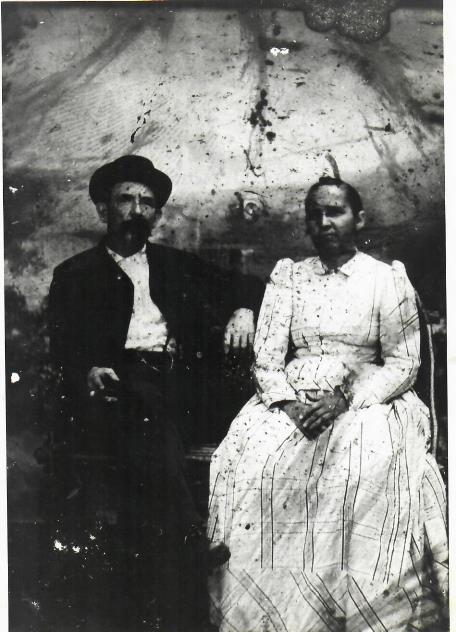
Because of his age he wasn’t able to enlist until 1865 when he turned 18. He was a volunteer soldier who served as a substitute for another man who was drafted.
After his discharge, he again enlisted in the Regular Army in 1866. He was assigned to the 13th U.S. Infantry, where he served one month before deserting at Jefferson Barracks, Missouri.
Samuel was married in 1867 (this may have some relevance to his decision to leave the military). He lived in Pennsylvania from the end of the war until his death in 1913. Shown here in 1876, Lebanon, PA.
Both his Regular and Volunteer Army enlistment forms are included here, along with the above photograph of Samuel with his wife circa 1876 from an early tintype. The forms look very similar, as each contains common information asked of a typical recruit. However they are decidedly different as the one covers his Civil War service and the other his post war service when he joined the regular Army after the men who served during the war would have been discharged.
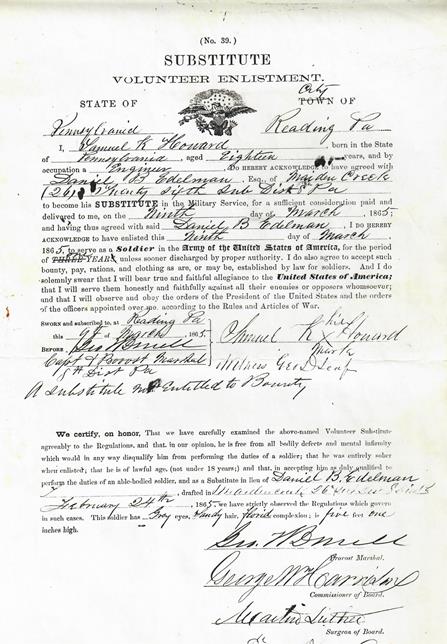
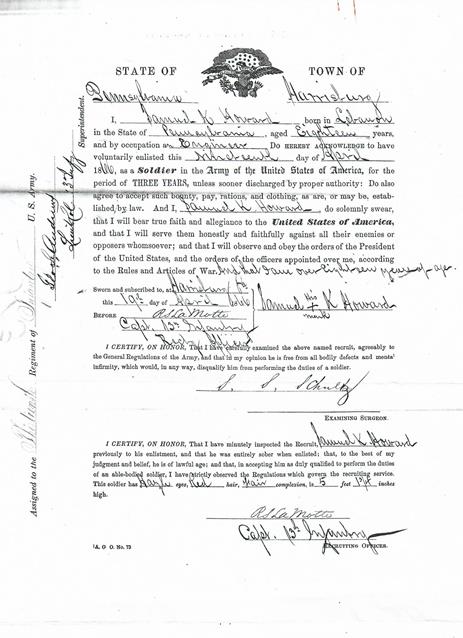
MyHeritage.com is the place to make connections with relatives overseas, particularly with those who may still live in your ancestral homeland. Click here to see what MyHeritage can do for you: it’s free to get started.
GEM: AN INSPIRING FAMILY HISTORY VIDEO

- Watch this inspiring Where I’m From video based on poem by Tom Boyer
- How to create your own family history videos
- Learn more about the Where I’m From poetry project and hear a conversation with the original author, Kentucky poet laureate George Ella Lyon in the free Genealogy Gems Podcast episode 185.
Hannah’s Animoto Advice:
You’ll find when using the video templates, timing the photos to the narration can pose some challenges. Originally, when she put the photos in place and “previewed” the video, the narration didn’t line up at all with the images. Hannah explains: “When I was in “creator” mode, I selected a picture that I wanted to appear on the screen for a longer duration then I clicked the “spotlight” button that is on the left-hand side in the editor column. Or If you double click the image, it will open into a larger single view and you can select the “star” button which will do the same thing. I applied this spotlight option to several photos within my gallery. I knew which photos to do this to by previewing the video several times to make sure I liked the timing of it all.
Now if your problem is not with just a few photos but the overall timing, then try editing the pace of your photos. In the top right-hand corner, click the “edit song/trim and pacing” button. Here you can trim you uploaded mp3 audio as well as the pace to which your photos appear. My photos appeared too fast on the screen in comparison to the narration I had, so I moved the pace button to left by one notch and previewed the video. This did the trick and the result was a heart-warming poem, turned into a visually beautiful story.”
Do you have a darn good reason to take action right now to get your family history in front of your family? Perhaps:
- a video of the loving couples in your family tree for Valentine’s Day
- a video of your family’s traditional Easter Egg hunt through the years
- a tribute to the mom’s young and old in your family on Mother’s Day
- your child’s or grandchild’s graduation
- a video to promote your upcoming family reunion to get folks really visualizing the fun they are going to have
- Or perhaps it’s the story of a genealogy journey you’ve been on where you finally busted a brick wall and retrieved an ancestor’s memory from being lost forever.
5 Steps to Jump-Starting Your Video Project
- Pick one family history topic
- Write the topic in one brief sentence ? the title of your video
- Select 12 photos that represent that topic.
- On a piece of paper, number it 1 ? 12 and write one brief sentence about each photo that convey your message. You don’t have to have one for every photo, but it doesn’t hurt to try.
- Scan the photos if they aren’t already and save them to one folder on your hard drive.
And now you are in great shape to take the next step and get your video made in a way that suits your interest, skill, and time.
4 Easy Methods for Creating Video
Update 2022: Adobe Spark Video is now part of and called Adobe Creative Cloud Express. Some or all of the features may require a subscription.
- Got an iPhone? iOS 10 now has “Memories” a feature of your Photos app that can instantly create a video of a group of related photos.
- There’s the free Adobe Spark Video app now called Adobe Express which can you can add photos, video clips and text to, pick a theme and a music track from their collection, and whip up something pretty impressive in a very short time. Visit your device’s app store or Adobe Express. Watch my video How to Make a Video with Adobe Spark (Premium Membership required)
- There’s Animoto which does everything that Spark does, but gives you even more control over the content, and most importantly the ability to download your video in HD quality. You can even add a button to the end that the viewer can tap and it will take them to a website, like your genealogy society website, a Facebook group for your family reunion or even a document on FamilySearch.
- And finally, if you have the idea, and pull together the photos, you can book Hannah at Genealogy Gems to create a video with your content. Go to GenealogyGems.com and scroll to the Contact form at the bottom of the home page to request ordering information.
The most important thing is that your family history can be treasured and shared so that it brings joy to your life today, and also, to future generations. The thing is, if your kids and grandkids can see the value of your genealogy research, they will be more motivated to preserve and protect it.
PREMIUM INTERVIEW: SYLVIA BROWN
In Genealogy Gems Premium Podcast episode #155, publishing later this month, Sylvia Brown (of the family connected to Brown University) will join Lisa Louise Cooke to talk about researching her new book, Grappling with Legacy, which traces her family’s involvement in philanthropy, Rhode Island history and the institution of slavery hundreds of years. A Kirkus review of this book calls it “an often riveting history of a family that left an indelible impact on the nation.”
PRODUCTION CREDITS
Lisa Louise Cooke, Host and Producer
Sunny Morton, Editor
Vienna Thomas, Associate Producer
Hannah Fullerton, Production Assistant
Lacey Cooke, Service Manager
Disclosure: These show notes contain affiliate links and Genealogy Gems will be compensated if you make a purchase after clicking on these links (at no additional cost to you). Thank you for supporting this free podcast and blog!
FREE NEWSLETTER:
Subscribe to the Genealogy Gems newsletter to receive a free weekly e-mail newsletter, with tips, inspiration and money-saving deals.
Resources
Genealogy Gems Podcast Episode 242 – Genealogy Research Questions
Podcast host: Lisa Louise Cooke
June 2020
In this episode we discuss how great genealogy questions and research plans can help you accomplish your family history goals. Then I’ve got ideas you can start using right away to manage distractions effectively.
Watch Elevenses with Lisa live on the Genealogy Gems YouTube channel on Thursdays at 11:00 AM Central. After the live show you can watch the video replay at your convenience. You’ll find the show notes for Elevenses with Lisa here on the Genealogy Gems website.
Research Plans and BSOs
On March 26, 2020 I started producing a new weekly YouTube Live show called Elevenses with Lisa. Originally it was in response to the fact that COVID-19 had created a situation where we were all staying home. For me that meant that all of my in-person speaking engagements for the foreseeable future had been cancelled or rescheduled. I saw it as an opportunity to take on a new challenge, which is live video production.
I love doing the live show on YouTube. It’s definitely different than doing a podcast. It’s more interactive which in turn makes me more animated. And obviously it’s a visual medium so it provides an opportunity to show as well as tell.
Of course, sitting down to watch a video is more stagnant than listening to a podcast. When you’re listening to a podcast you can still move about and get things done if you want. So, I’m sure there are some of you who haven’t seen the Elevenses with Lisa show yet. That’s why in this episode I’m bringing you a few highlights of the YouTube Live show in audio form.
In episode 2 of Elevenses with Lisa I talked about the importance of creating research questions and plans. This was the first presentation in a series called How Alice the Genealogist Avoids Falling Down the Rabbit Hole. If you want to stay on track and achieve your genealogy goals, a research plan is really essential.
Then in the third episode I talked about “Bright Shiny Objects”, also known as BSOs, that can distract you from your research plan. I shared the techniques I use to deal with them so that I don’t miss a good thing while still staying on track.
If you watch the show this will be a refresher for you, and if you haven’t gotten around to watching it, I hope it will inspire you to join us in the future, as well as help you improve your genealogy research today.
You will find the complete notes for the topics discussed in this episode (and more) in the show notes web pages for these episodes of Elevenses with Lisa:
Episode 2 – how research questions and plans will improve your genealogy research.
Episode 3 – dealing with Bright Shiny Objects that threaten to get you off track.
Get the Entire “Alice” Video and Handout
If you enjoyed this portion of How Alice the Genealogist Avoids the Rabbit Hole and you’re a Genealogy Gems Premium member, I have the entire presentation edited together in one complete video class for you in the Premium Videos area at genealogygems.com.

Premium Members get the entire video class plus 7 page downloadable handout.
There you can also download the complete handout which is ad-free and 7 pages long. It includes not only research plans and BSO management but also creating supportive research environments both on your computer and mobile devices.
Become a member here.
GEM: June Weddings
Monday, June 15.
For centuries, the month of June has been the most popular choice for weddings.
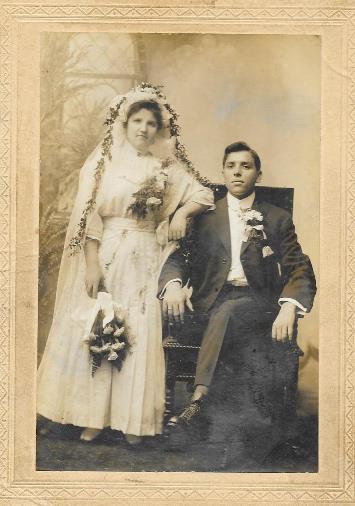
All about June Weddings – Genealogy Gems
One of the purported reasons was that some hundreds of years ago, this time was just after May’s annual bath, so the happy couple and the guests were about as clean as could be hoped.
With the ensuing advances in plumbing and overall hygiene, dressy weddings are readily staged year-round, from simple civil ceremonies and backyard or back-to-nature vows, to elaborate church functions. In normal years, there are more than 2.2 million weddings across the nation.
The median age at first marriage for women is now 28 years— up six years since 1980. Men are now an average age of 29.8 when they take their first vows.
Sources:
June weddings, accessed 2/3/2020
Number of marriages, accessed 2/3/2020
Getting Your History Digitized
Our family’s history comes in many forms, and some of them over time can become obsolete. I shared in this episode my continuing progress on my own project of converting the rest of my old home movies that are in a variety of formats (8mm, mini DV, High 8, and VHS.) I use Larsen Digital and have been extremely pleased with the service and results. The folks at Larsen Digital have put together special and exclusive discounts for Genealogy Gems listeners and readers. Click here to learn more and receive exclusive discounts and coupon codes.
Read more: 5 Steps to Digitizing Your Old Negatives

Learn how to tackle the task of digitizing your old negatives at Genealogy Gems
Get the Genealogy Gems Podcast App
Get the right app for your phone or tablet here.
Follow Lisa and Genealogy Gems on Social Media:
Instagram.com/genealogygemspodcast
Facebook.com/genealogygems
Pinterest.com/lisalouisecooke
YouTube.com/GenealogyGems

follow Lisa Louise Cooke on Instagram
Get the Free Genealogy Gems Newsletter
The Genealogy Gems email newsletter is the best way to stay informed about what’s available with your Premium eLearning Membership. Click here to sign up today.
Download the Show Notes


